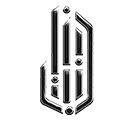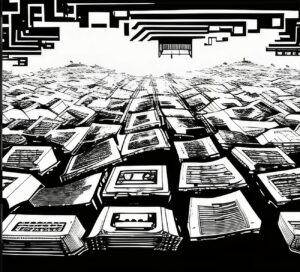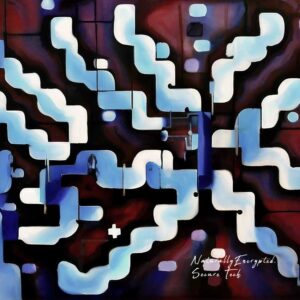AMA Recap: NESTECH x Cryptotalkz
Here at NEST®, we believe an insightful AMA session is essential to building our community’s awareness and deep understanding of our ecosystem. And that’s precisely what took place recently on the 26th of November.
The AMA Session goes by the title “Crypto Talkz AMA” and was held at NEST®’s Discord server with Caitlyn, our host, and Charles Anderson, NEST® Founder and CEO discussing the project and answering questions from the community.
With three segments, Getting to know NEST®, Answering Twitter Questions, and Live Q&A, Crypto Talkz AMA came to a successful wrap.
Getting to know NEST®
NEST® stands for Naturally Encrypted, Secure Technologies. We focus on bespoke development of easily accessible infrastructures and software that facilitate secure user access, ownership, and control of Web3.
The NEST® team comes from a variety of backgrounds, but — mainly, the developers left places like IBM, Accenture, Google, and others to work on the NEST® suite
We believe in the right to privacy and private, confidential control — everything we do is guided by ensuring people have direct access to this.
What makes NEST® different?
Nothing is truly decentralized until the users are in charge of every element of their digital assets. NEST® is a blockchain network for Self-Sovereign Distributed Identification (SSDID), instant data-asset creations and registrations such as Non-Fungible Tokens (NFTs), hyper-encrypted data storage, provenance authentication, notary signatory and contractual engagement, secured social and private messaging as well as for interoperable transactions, exchanges, and activities.
Users’ privately controlled personal ID (SSDID) can be implemented into smart contracts. This enables off-chain data connectivity across almost any selected network and off-chain or real-world data for any chosen data-as-an-asset.
Fundamentally we allow for individually encrypted and private control of assets, contracts, and exchanges.
Partnerships
We’re finalizing several partnerships that show excellent signs for the broader community and extended use cases.
In particular, there are decentralized marketplace functions that mitigate the risk of both digital and real-world exchange. There are in-real-life use cases for encrypted NFTs, which allow the participants to have secured ownership and redemption/use of their assets… We’re seeing these and a few others being readily adopted by major players and corporations that we didn’t previously think would participate in Web3.
Despite all the recent bad news and macro-environments — we see a strong future for the space in a variety of ways.
Achievements
We’re most proud of practical implementations. Showing the use cases and how these solutions genuinely impact both the users and communities.
We’re incredibly proud of the multiple patents for real-world encrypted exchange on the blockchain. One of the more underlying, significant portions is the ‘layer-zero’ blockchain, which is a unique combination of a DAG + EVM. This will be shortly opened up to developers for direct contributions.
Answering Twitter Questions
Q1: What do you think is necessary to compete with the top-tier projects offering similar products? How will you achieve being a globally known project?
There are many excellent projects out there, yet the focus on private ownership and real-world control is largely unanswered and still truly necessary for permitting the next stages of use cases. We focus on education and reliance on the practical implementation of our solutions — the global recognition comes from users.
User-led and functional implementation is always the focus.
Q2: For NEST®, user identity and personal data are everything. So, what encryption technologies have you implemented to protect user identity and data security within the NEST® platform? Is KYC required to access the NEST® platform?
We are purely non-custodial — in every sense — and only give the recall/read/write/decryption ability to the user himself or herself. We can never know or decrypt this ourselves. It’s a layered combination of PGP, RSA, AES, MPC, and ZKP with the W3C standards for verified credentials (also using ZKP), as some of the foundational elements.
The encryption also extends into the use of networks themselves. Rather than ZKP just for an exchange, we first have ZKP and personal encryption from the device side. This means an ability for decentralized storage that is quantum-proof and unhackable.
Q3: So, your NFT Marketplace will be full-featured. What are your main features, and are transaction fees low?
It is a marketplace different from what people commonly associate with an NFT sales or exchange platform. In particular, the RWSC (real-world smart contract) can accommodate any type of exchange, whether digital or real-world engagement. It further allows the funding or settlement of exchange to be truly individually encrypted between the participants. It is entirely legal, although fully private, only shared by a participant in the encrypted contract when they wish to share it.
From a feature level, it’s far more comprehensive in the potential for users to set their own terms of engagement and pay or get paid as they wish. For the low transaction fees — we have a unique combination of encryption and GSN networks as well as on-chain oracles. This allows for very lightweight contracts in transmission, double accounting (from our layer zero and then to the selected network of choice), and payment for this using fiat. In short, a very lightweight choice selection that does not require the holding of native tokens by the parties to execute.
Q4: Security audits are extremely important for any project. Has your project been audited?
Yes, we have. And there are two types of audits to consider.
The first is external contracts. These are the token standards, smart contracts for exchange, exchange mechanisms, etc. Basically, all the DLT solution features that need to be public are subject to standard audits, and we’ve completed multiples for each of them.
The second type of audit — which most people, I believe, don’t consider — is something like ISO27001. This internal and structural level audit guarantees the network integrity; basically, we do everything we say at every portion.
We’re proud to work with ISO27001 and other SOC and compliance standards, such as GDPR and ICO.
Q5: Explain the advantage of creating NEST® SSDID to import, mint, and securely store all your data assets?
Great question. Years ago, we saw that the ability for users to own and control their SSDID is not only important but necessary. Nothing else in the space works without it.
If users’ do not have ownership control and the personally encrypted, confidential ability to choose whatever feature or function across Web3, then Web3 cannot exist.
Suppose users’ do not have this same confidential control. In that case, all the systems in the blockchain and Web3 space are fundamentally just copies of centralized services. There will always be an intermediary, a company, or a ‘middle man’ controlling aspects of what’s possible.
We know that there is no Web3 / Web5 without the SSDID. So — it isn’t so much of a question about demand or percentages of the market requiring it. It’s more about education and making everyone aware that they each have the right and choice to choose independently.
Live Q&A
How can we take full control of our privacy with a decentralized digital identity? Does NEST® offer users complete control over all areas?
Full privacy control starts with owning and controlling your SSDID / personal information. It does not stop there, nor is anything a one-hit solution. The SSDID is the capacity to decide for yourself when/how/where you choose to use or disclose your data. Only with this can you genuinely own or exchange anything on your terms. This also extends to the ability to truly own (personally encrypted) NFTs, wallets, and assets.
NEST® offers full control over these areas, but there are always different use cases, extensions, and options. In short — it’s the start. But it has to happen, and you, for the first time, have to be in charge.
Anyone can easily access the massive music industry, which is a global lingua franca. What strategies will you employ to persuade consumers that, thanks to Listenify, they may earn significantly from investing in the music they enjoy?
Great question. Two elements come up here with the music industry or streaming in general.
- The ability for authenticated provenance for the artists/creators and providers. This has a knock-on effect on ongoing royalties and enhanced IP rights (as we’re talking about the SSDID and self-monetization capacities).
- Controlled or encrypted streaming. Because there is the ability, with the SSDID, to have confidentially confirmed initiation and consumption of the data or media, artists and consumers can be protected in a private and decentralized manner.
Anyone from any walk of life and from any media should have the individual choice capacity to earn / pay / get paid as they wish. Regardless of the network
Is the utility of the token one of the factors that evaluate the credibility and potential of the network?
We permit device-side contributions from not only a network perspective but also a CDN and read-write functionality. We have a quantum-proof CDN network that is user-led and structured.
The functional utility is not only in the ability to mint NFTs, own or control assets, or do first-level engagements. The utility of this network is also weighted by device-side contributions and environment ranking. So the idea of utility is a) for the execution of exchanges and features, b) defined by the use of all networks/ecosystems throughout the community.
How does NFT technology address the critical points of #digitalticketing, and what are the benefits of adopting #Web3 technology in the current Web2 scenario? Why Choose Web3?
Because without authenticated provenance for the ticketing issuance and then authenticated individual use of the ticket — there is no genuine control of the asset. With ticketing, we permit real-world use (e.g., scanning or attribution use), which is confidentially authenticated from the issuer and then used by the holder. This stops the potential for slippage and re-sales and turns the ticket itself into a dynamic asset.
The SSDID and authenticated engagement structure are the unique components to close the loop.
Have you taken any measures to protect customers from scammers?
The NEST® environment provides a hyper-secure structure for individually encrypted wallet ownership, control, and management. So from a topical perspective, the scammers are out of luck for a number of activities or potentials.
Then, with, say, real-world engagement contracts or minting / owning NFTs, we are talking about individual encryption, private control, and certification verified through the SSDID. Every risk is mitigated on a one-on-one or singular basis. There is no potential for a centralized breach — because nothing is centralized.
If you like this content, make sure to follow our socials to stay updated, and join our Discord community to get more information like this!





